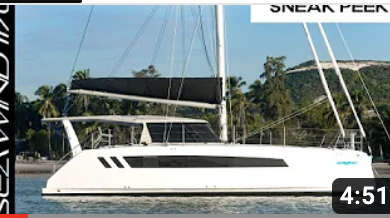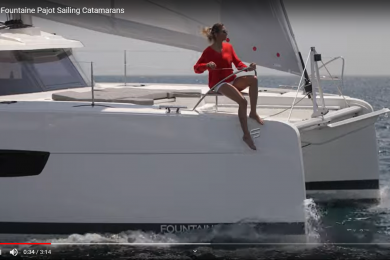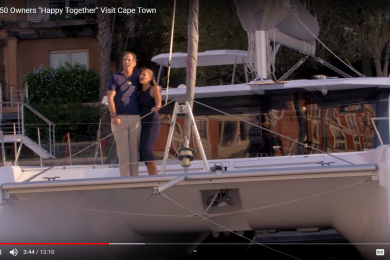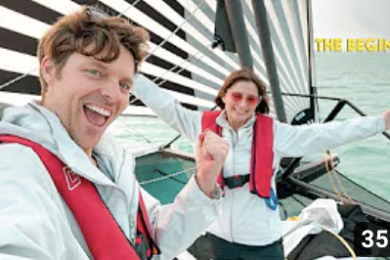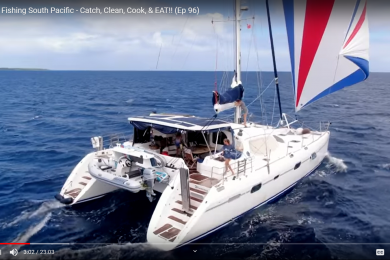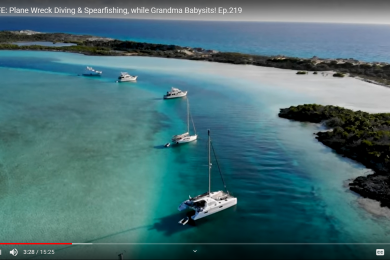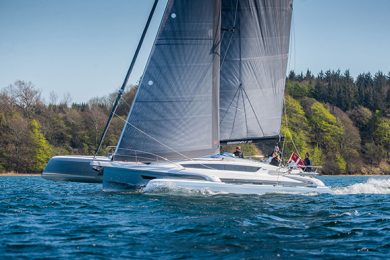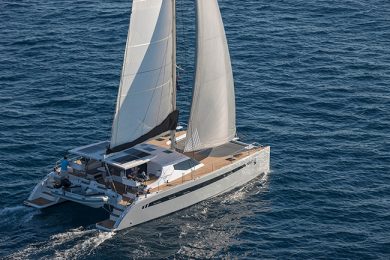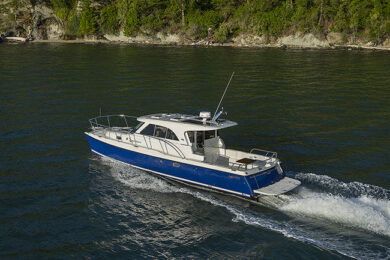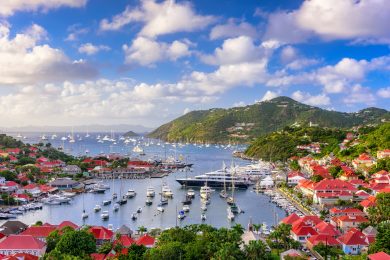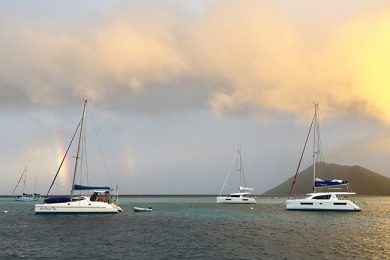Morello, a 40-foot Tony Grainger designed trimaran, makes one feel like a water spider skating across the surface of the sea, barely breaking the surface tension (Published Winter 2016)
We sailed out of Gorda Sound and, on a 15 knot gust, immediately shot up to 14 knots of boat speed with the windward hull airborne. Its acceleration and response to sail trim is amazing. Sailing at a close to beam reach with 12 to 14 knots winds, Morello easily matched, sometimes exceeded, wind speed.
The passage to the Caribbean for Larry and Amy Ketten from Harbor Springs, MI, was a major milestone. Their adventure began 20 years ago in 1995 when Larry, a boat builder by trade, began to create his own trimaran. Amy assisted Larry in the process between shifts as a nurse in the local hospital.
Larry had been studying trimaran designs since his youth and finally settled on the Grainger TR40. Tony Grainger is an Australian designer, well known for his high performance, offshore trimarans. Only two TR40’s have been built. Morello’s sister ship Yana was completed in Amsterdam and has several transatlantic passages under her hulls.
Morello, named for a character in the movie,”Tonight You’re Mine,” was launched last spring. Larry and Amy brought her across the Great Lakes to the Erie Canal, down the Hudson River, and into the Chesapeake Bay before joining the Salty Dawg Rally in Hampton, VA in late October.
Sailing to the B.V.I., Larry was impressed by the power of the boat. In the Gulf Stream, Morello sailed on a close reach in 20 to 25 knots of wind with gusts to 32. With two reefs, her speed reached between 18 and 22 knots. From the Stream to the B.V.I., the boat sailed mostly hard on the wind, targeting nine knots of boat speed.
“It took a while to convince our crew that it was more comfortable….and safer….to slow the boat down. It’s easy to sail in light to moderate conditions but I get nervous when things freshen up and the speed and loads increase!” Larry said. “The passage to the BVI proved to be challenging for Amy and me but Morello far surpassed our expectations both in performance and structural integrity.”
When asked about Morello’s top speed, Larry indicated that their best run so far has been 55 nautical miles in three hours, sailing on an offshore breeze with 15 to 18 knots of wind with some gusts a bit higher and flat water. Top speed to date has been 24 knots.
This trimaran is like no home-built boat you have ever seen. The workmanship is exquisite. No corners cut. The joinery is perfect and the brightwork glistens. The cedar hull is covered with fiberglass, 16 ounce below the waterline, 12 ounce above.
Surveyed near the end of the construction process, Morello earned praise from surveyor Marc W. Nugent from Traverse City MI. “The vessel was very well built, and to a level of craftsmanship rarely seen,” wrote Nugent in his survey report. He was particularly complimentary about Morello’s exterior finish, saying “The exterior of the vessel was professionally painted with a two-part paint. The Awlgrip paint was installed extremely well, and did not contain any visible blemishes.”
Harking back to its Polynesian heritage, a trimaran uses unique names for the main components of its design. The main hull is referred to as the vaka, the outboard hulls as amas, and the supports or arms are called akas.
The vaka and the two amas on Morello are constructed of red cedar strip planking with fiberglass/ West System epoxy inside and out. The akas have plywood webs and carbon fiber flanges with additional fiberglass reinforcements. The total width of the vessel is 32 feet.
“We were very weight conscious during the build and chose techniques such as vacuum bagging for all exterior laminates. Also when outfitting the boat we would consider weight and cost to try to maximize the bang for the buck,” said Larry.
The fixed mast from Hall Spars is carbon fiber, as is the rudder from Composite Solutions and the sprit. But the boom is aluminum. The weight savings to add a carbon fiber boom did not justify the expense. Dyneema rigging and fittings replace stainless steel shackles and turnbuckles.
The fractional rig stands tall at 59 feet off the deck. The shrouds and stays are made of Dyneema Dux, a pre-stretched composite braid designed for higher load than the stainless steel rigging originally specified in the design.
Sails are from North Sails and are made of a Spectra laminate material. The 80 percent jib (on a Harken roller furling system) and 780 square foot main with three reef points are the workhorse sails for Morello offshore. A 100 percent jib alternates with the smaller jib on the forestay. An 800 square foot screecher and 1600 square foot asymmetrical spinnaker are at the ready for light air work.
At 7,500 pounds dry weight (10,000 lbs at cruising weight), Morello flies. The amas or floats, as Larry calls them, weigh 600 pounds each. The center hull sits a mere 24 inches in the water (but the rudder extends to four feet, nine inches) with its centerboard up. With the centerboard down, Morello draws eight feet, nine inches. Unlike racing trimarans, Morello is designed to sail the windward ama, but keep the center hull/vaka in the water.
Morello is powered by a 27 horsepower Yanmar 3GM30F engine with a shaft (rather than saildrive) and a 16 inch feathering Max Prop. The electrical system is all 12 volt. A 160 amp alternator and two 75 watt solar panels charge the battery bank of three Group 31 Firefly AGM batteries. The start battery is a small Odyssey AGM battery.
The laminated wood tiller with its carbon fiber tiller extension adds to the responsiveness of the vessel. A hydraulic autopilot served the crew well during the passage.
Morello is designed with a large centerboard that can be raised and lowered with lines run to cockpit winches. The deep fin rudder, designed to fit into a cassette through the aft deck, can also be retracted with a line from the boom or halyard system.
Interior bulkheads and furniture are Okoume marine plywood and reinforced with fiberglass as specified in the plans. The interior is mostly painted, with sitka spruce trim. The interior in the center hull is light and airy with a double bunk on the starboard side and two pilot berths on the port. A full sized nav station equipped with a mounted iPad for navigation is at the bottom of the companionway to port. The galley with its two-burner propane stove is to starboard. A quarter berth/storage area is nestled aft of the nav station. The head is in the forepeak. Accommodations are small, but utilitarian and suited the two passage-makers and their crewman well during the trip to the Caribbean.
From a safety perspective, Morello includes key elements necessary for an offshore trimaran. As required under ISO standards, a large escape hatch is installed above the sealed waterline in the main hull/ vaka. The hatch is installed where it cannot be blocked by equipment or gear. It is closed with toggles that allow it to be opened from the exterior, if the vessel flips over.
The forward and aft bulkheads are designed with watertight panels, which create sealed compartments. This way, if one compartment is breached or punctured, only that compartment will flood. The surveyor commented that “This is a very safe way to build a vessel.”
Under the floorboards are approximately 18 watertight compartments in the bilge. A manual Gusher bilge pump is installed so it can be operated from the aft cockpit. The pickup hose can be moved between compartments.
After their arrival in the British Virgin Islands, Larry said, “Sailing has been fun and challenging, The boat performs way beyond our expectations.”
The addition of a dodger is top on their list for boat improvements after the passage. “I felt like Kilroy peering over the companionway bulkhead trying to see what was ahead, only wind and saltwater. We need a dodger to protect us from the wind, sun,and sea while we in the cockpit, and help reduce the amount of seawater that gets below while we are offshore.”
And the adventure continues….
